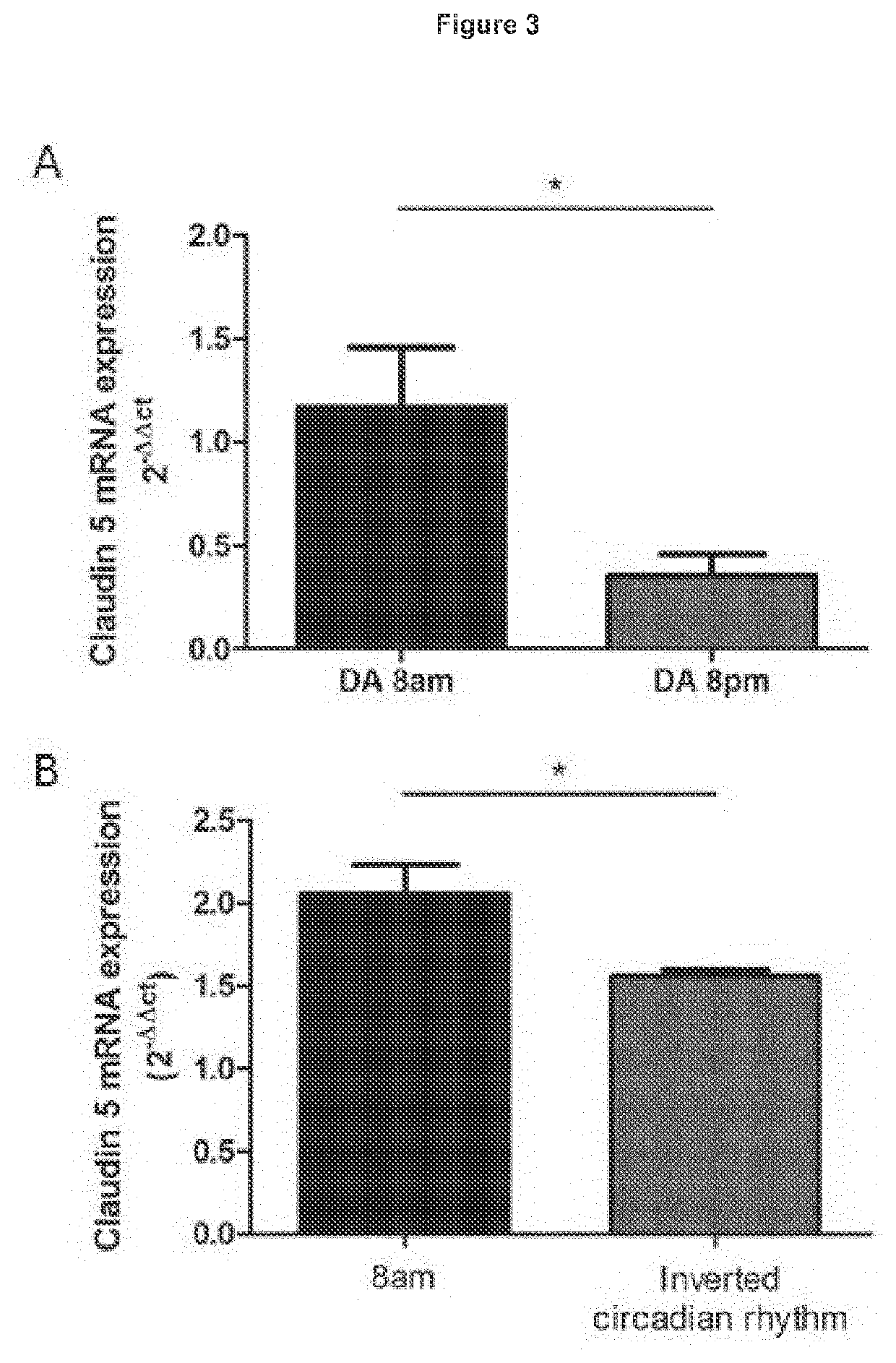Treatment of age-related macular degeneration
a macular degeneration and age-related technology, applied in the direction of peptide/protein ingredients, pharmaceutical delivery mechanisms, pharmaceutical active ingredients, etc., can solve the problems of vision loss, amd is the leading cause of central retinal vision loss worldwide, and amd is the leading cause of central retinal vision loss, etc., to and restore the natural circadian cycling of proteins
- Summary
- Abstract
- Description
- Claims
- Application Information
AI Technical Summary
Benefits of technology
Problems solved by technology
Method used
Image
Examples
example 1
is Regulated by the Circadian Clock
[0143]Circadian rhythms are 24 hour oscillations in behaviour and physiology in response to environmental cues, primarily daylight and darkness. A conserved transcriptional-translational regulatory loop involving core clock components, gene protein products, are necessary for generation and regulation of circadian rhythms within individual cells. It was determined that claudin-5 was cycling in a circadian rhythm in all organs analysed (see FIG. 1). In tandem, claudin-5 protein levels are significantly decreased in the evening (8 PM) when compared to the morning (8 AM) in mice (see FIG. 2a, b). While in vitro, cells lose their circadian rhythm, following serum shock, it is possible to reset the circadian clock transiently. In primary mouse brain endothelial cells, serum shock induced cycling of claudin-5 in 12 hour phases similar to that observed in the retina and peripheral organs (see FIG. 2c). This response is circadian rather than diurnally regu...
example 2
Suppression and Supplementation of Mice With a High Fat Diet Induces Geographic Atrophy-Like Phenotype
[0145]Given the phenotype observed with regard to enhanced fluroescein leakage at 8 PM, it was sought to induce this phenotype for a prolonged period of time using an adeno-associated virus (MV) vector expressing claudin-5 shRNA under the control of a doxycycline inducible promoter. To this end, 10 C57BL / 6 mice were injected sub-retinally with AAV-luciferase into their left eye and AAV2 / 9 claudin 5 into the right eye. Five mice were left on normal diet (ND) and the remaining five placed onto a high fat diet (HFD) with all mice on doxycycline water (2 mg / ml) to induce shRNA expression. Six weeks post-injection, FFA analysis showed enhanced leakage of fluorescien in the AAV2 / 9 claudin-5 eye compared to the AAV-luciferase injected eye (see FIG. 10). Post mortem analysis of eyes from these mice revealed a retinal pigment epithelium (RPE) phenotype similar to that observed in human subje...
example 3
Claudin-5×Tie2Cre+ Mice Have a ‘Leakier’ Inner Blood-Retinal Barrier
[0146]As mice that are deficient in claudin-5 are embryonic lethal, a new mouse model was generated that allows for inducible suppression of claudin-5. These mice are then crossed to the Cre-recombinase expressing (Tie2Cre) mice and animals that are Cre positive have suppressed levels of claudin-5 in their retinal endothelial cells when administered doxycycline in drinking water. Claudin-5×Tie2Cre mice were administered doxycycline for two weeks and then imaged by fundus fluorescein angiography (FFA) (see FIG. 12). Inducible claudin-5×Tie2Cre+ mice have more permeable retinal vessels when compared to their Tie2Cre− littermate controls.
PUM
| Property | Measurement | Unit |
|---|---|---|
| body temperature | aaaaa | aaaaa |
| flip angle | aaaaa | aaaaa |
| thickness | aaaaa | aaaaa |
Abstract
Description
Claims
Application Information
 Login to View More
Login to View More - R&D
- Intellectual Property
- Life Sciences
- Materials
- Tech Scout
- Unparalleled Data Quality
- Higher Quality Content
- 60% Fewer Hallucinations
Browse by: Latest US Patents, China's latest patents, Technical Efficacy Thesaurus, Application Domain, Technology Topic, Popular Technical Reports.
© 2025 PatSnap. All rights reserved.Legal|Privacy policy|Modern Slavery Act Transparency Statement|Sitemap|About US| Contact US: help@patsnap.com



